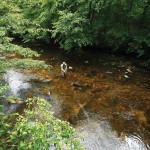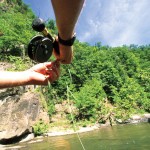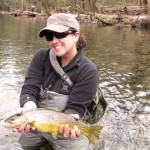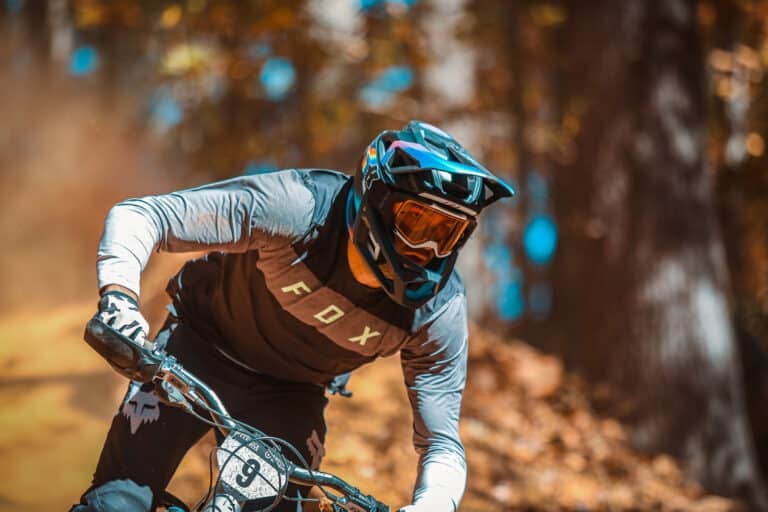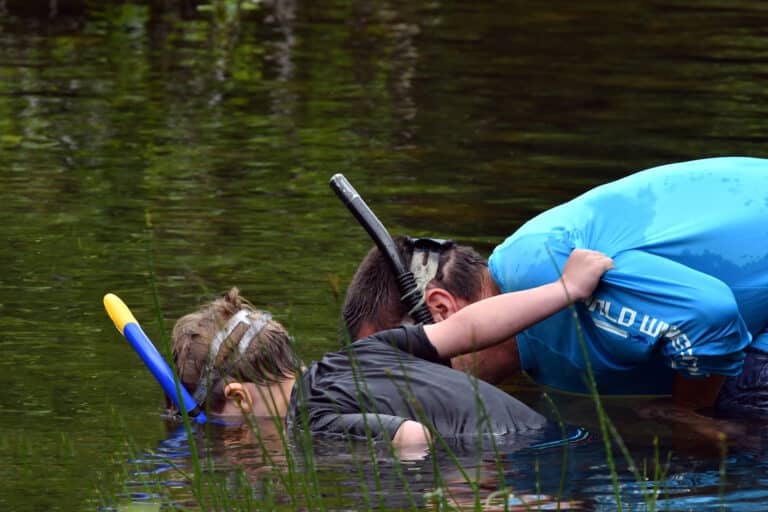Reba Brinkman and a brown trout.
The Southern Appalachians has thousands of miles of trout streams. Here are four classic destination rivers that should be on every angler’s must-fish list.
ELK RIVER
West Virginia
Locals call it “The Lady,” because it’s so fertile. The river starts at Slatyfork, where Big Spring Run and Old Field Fork join, then goes underground for six miles before popping back out at Elk Springs in the form of three cold springs, and heads west toward Charleston. Head for the 4.6-mile stretch from the headwaters to the dries, where the river heads underground. This upper stretch, known as the Slatyfork section, is narrow, rocky, and shallow, but has plenty of cover to keep the river cool in the summer. It’s catch and release, and a stellar wild trout fishery. Expect to find naturally reproducing brown, rainbow, and brook.
“The Upper Elk has the largest naturalized population of trout in West Virginia,” guidebook author Beau Beasley says. “It’s catch and release, so you’re not going to find as many conventional anglers in the area because they have to let the fish go.”
Since the fish populations have been naturalized, they’re more wary than what you’ll find in stocked West Virginia streams, so bring your A-game.
Access: From Slatyfork, take County Route 219-12 north for 0.5 miles to a trailhead servicing the catch and release section of the Elk. Follow the former rail line along the river.
NORTH FORK MOORMANS
Virginia
The North Fork Moormans is a tight, rugged trout stream that starts near Skyline Drive inside the Shenandoah National Park and eventually feeds the drinking water reservoir for Charlottesville, before mellowing out into a wider river. The headwaters inside the park offer some of the best native brook fishing in the state.
“Some of the largest native brook trout in Virginia are found in the North Fork Moormans. It’s not unusual to pull out a 12 to 14 inch brook with a good, thick body,” says James “Chubby” Damron, vice president of the Virginia Council of Trout Unlimited and author of the forthcoming Fly Fishing Guide to Jefferson Country. “Plus, there are over five miles of stream with public access, so you can camp and fish and head up into the upper parts and never see anyone else.”
The section inside Shenandoah National Park is catch and release only. A massive flood in the ‘90s wreaked havoc on the trout populations and habitat, but the headwaters have bounced back.
Access: Hike-in only. Park at Blackrock Gap on Skyline Drive at milepost 87 and walk down the North Fork Moormans River Road until you find the stream.
SOUTH FORK HOLSTON RIVER
Tennessee
If you want big fish, and lots of them, you go to the South Fork Holston, a tailwater stream that’s fed by the bottom of the South Holston Dam, which provides trout-friendly ice-cold water year-round. The river is famous for two things: big wild browns, and the mass hatching of sulphur bugs almost daily from April to November. Show up in the summer, and you’re almost guaranteed to see a massive bug hatch, which means the trout are popping to the top of the river to dine. This tailwater section of the river is home to 5,000 trout per mile, about a quarter of which are wild browns. Most anglers like those odds.
“This is one of the classic Southern trout fisheries,” says Fly Fishing Team USA member Josh Stephens. “But even with high fish populations, it’s still fly fishing, which means the South Fork Holston can reward you one day and frustrate you the next.”
The South Fork Holston is also a wider river, which will allow you more room to practice casting for distance.
For large browns that push the 20-pound size, fish the tailwaters between the dam and Bluff City. This section of the river provides fish that rival anything you’ll find in world-famous Western rivers like the San Juan in New Mexico. Pay attention to the TVA dam generation schedule. If you’re fishing while the TVA is releasing water, you’d better be in a boat. Otherwise, wading is an option.
Access: If you’re wading, there’s a walk-in area off of River Bend Road and another just upstream from Emmet Bridge.
DAVIDSON RIVER
North Carolina
The Davidson could be the most well known trout fishery in North Carolina–it even made Trout Unlimited’s Top 100 Trout Streams list–but for good reason: It’s home to some very large trout.
“It’s the only place in Western North Carolina where you can see a 24-inch fish, just laying out in front of you,” says long-time guide Forrest Marshal. “There’s a mile-long stretch around the hatchery where you can stand right beside these massive fish and look them right in the eye.”
The river is as clear as moonshine, which allows you to spot the massive trout before you start tempting them with flies, but the transparency works both ways. As a rule, you should assume that any rainbow you spot in the Davidson saw you ten minutes earlier and assessed you as a non-threat. These fish are used to humans and have become so large because of regular feedings from the hatchery. So expect a finicky prey…and crowds.
The hatchery stretch of the Davidson will host a dozen anglers even during the week. You can head higher into the Davidson River Gorge or lower towards Avery Creek for more solitude, but expect smaller fish.
“Even though the Davidson is crowded, it’s still a unique experience,” Marshal says. “It’s still cool to take a beginner down there, put a fly rod in their hands for the first time, teach them a couple of things, and watch them catch a 20-inch fish.”
Access: Park at the Pisgah Forest Fish Hatchery, off FS 475 near Brevard, and follow the trail downstream.
School of Fish
Want to learn how to cast from the best? Enroll in an Orvis Fly Fishing School. Orvis, maker of fine fly rods, began the country’s first fly fishing school in 1966 and quickly became the industry standard for teaching beginners how to fish with flies.
“There’s a continuity to the training you find at an Orvis school,” says Orvis instructor Reba Brinkman (see Brinkman’s tips for beginners below). “It’s a proven method of teaching. At Orvis, you learn a foundation that you can take and fish anywhere.”
Graduate from a two-day Orvis school, and you even get a diploma. There are only 15 Orvis schools in the country. The Southern Appalachians has four.
ORVIS TENNESSEE FLY FISHING SCHOOL SEVIERVILLE, TENNESSEE Taught at the Hidden Mountain Resorts, you’ll start off at the casting pond and eventually have the chance to land wild trout inside Great Smoky Mountains National Park. hiddenmountain.com
THE HOMESTEAD FLY FISHING SCHOOL HOT SPRINGS, VIRGINIA Learn the Orvis methods, then test them out on Cascades Stream, a privately owned trout stream on the Homestead that features 20-foot waterfalls and classic Southern Appalachians fishing.
NEMACOLIN WOODLANDS RESORT’S ORVIS FLY FISHING SCHOOL FARMINGTON, PENNSYLVANIA There’s a lot of fishable water nestled inside Pennsylvania’s Laurel Highlands. At Nemacolin’s school, you’ll have the opportunity to fish some of the area’s prettiest streams, including the Youghiogheny River and Beaver Creek.
NORTH CAROLINA FLY FISHING SCHOOL AT THE BILTMORE ASHEVILLE, NORTH CAROLINA Begin your journey to fly-casting superiority on ponds with the Biltmore in the background, then move on to legendary trout streams like the Davidson and Mills River.
Fly School: Get an introduction to fly fishing from Orvis.
Start Here
Three tips from Reba Brinkman, Orvis-endorsed instructor at the Biltmore Estate and founder of WNC Women on the Fly.
1. Casting is the most intimidating part of learning how to fly fish. People think it’s difficult, but if you have the proper training, it’s not hard to learn. It’s really important to build that skill at the beginning.
2. Eighty percent of a fish’s diet is sub-surface. I look under rocks at the stream for aquatic bugs, then find the fly in my box that matches it closely in color. Or just use a fly that matches the color of the river bottom.
3. Focus on fishing just a few local rivers and master them. Get to know these home waters by making a friend at a fly shop. A local resource can be extremely helpful to learning how to fish and where to fish.

